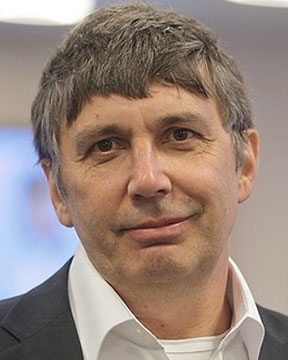ORALS
SESSION: ManufacturingWedPM2-R4
Environmental Aspects / Impact on Climate Change | Mamalis International Symposium on Advanced Manufacturing of Advanced Materials and Structures with Sustainable Industrial Applications |
| Wed Nov, 7 2018 / Room: Sao Conrado (50/2nd) | |
| Session Chairs: Sesh Commuri; Session Monitor: TBA |
17:10: [ManufacturingWedPM212]
Stroboscopic Method of Fluorescence Analyses of Optically Dense Media Nugzar
Gomidze1 ; Izolda
Jabnidze
1 ; Zhuzhuna
Diasamidze
1 ; Lali
Kalandadze
1 ; Omar
Nakashidze
1 ; Kakha
Makharadze
1 ; Miranda
Khajishvili
1 ; Zebur
Surmanidze
1 ;
1Batumi Shota Rustaveli State University, Batumi, Georgia;
Paper Id: 275
[Abstract] Anthropogenic pollution includes various components, and the first place nowadays belongs to oil and oil products, as well as a number of organic compounds. Fighting against this pollution is a modern problem [1,2]. According to statistical data, the annual anthropogenic flow of oil products in the sea is caused by the loss of oil on tankers, and protecting the environment from pollution is closely related to its discovery and then its control. This is a difficult problem, since the pollution factors represent a complex of different complicated organic substances. After being in water, many different processes take place (for instance: transfer in atmosphere, degradation, influence of biological factors etc.), which are less studied. A number of methods of watery media analyses have been applied and studied so far (for instance: infrared spectroscopy method, core magnetic resonance on Shpolski effect, gravitational or weight method, chromatography etc.). It is concluded that the limited accepted concentration in sea water is 50 mkg/L [3,4].
The organic substances are conditionally divided in four classes; they are: photosynthesizing substances, phytoplanktons, amino acids, water humus-like substances, oil, and oil products [5]. There are always fluorescence solved organic substances in water media. Their fluorescence signal makes up a background on oil fluorescence signal, and it significantly blocks its discovery. We receive the fluorescence spectrums simultaneously, which reflect the spectrums received from both oil and other organic substances. There are different ways of separating these spectrums [6], but none of them are perfect. Due to this reason, it is required to investigate the spectrums of fluorescence of additional organic substances apart from oil and oil products. It is rather easy to discover the solid particle floating in the water and substances and to determine their concentration [7].
Nowadays, for discovering and studying the oil products and organic compounds in water, spectral optical methods are used; its principal advantage in contrast to other methods is their express-diagnostics and distance. The express-diagnostics implies the quick discovery of pollution in water via optical methods in order to eliminate the pollution sources on time and liquidation of pollution sources as possible (we mean tankers, terminal etc). Though, there are some differences even among optical methods. One of them is laser fluorescence [8,9].
Fluorescence represents a physical process and is considered as one of the kinds of luminescence. When radiating a substance with light, it is possible for the electron to move among the different levels of energetic levels. The difference of energy among the energetic levels and the frequency of absorbed light oscillation are connected to each other with Bohr's third postulate. While absorbing light, the part of the energy received by the system is used for relaxation and the other part is radiated in the image of photon of determined energy. Schematically, the photon radiation and the absorption is expressed with Iablonski diagram. Fluorescence spectroscopy represents the effective method of studying dynamic processes in solutions. This method will be greatly applied in biology, medicine, material studies, nanotechnology, and of course, ecology. The parameters of fluorescence spectroscopy, such as radiation spectrum, life duration, quantum yield, and fluorescence anisotropy represent the sensitive functions of the processes, which depend of the life duration of excited condition [10,11]. The molecules can participate in these processes which are in 10 nm distance from fluorofore at the moment of excitation.
The molecular system is not entirely characterized with the own fluorescence in more or less intensity. Polysaturated, condensed, and of course, aromatic and polyaromatic compounds fluorescence well. Hetero atomic or electron-domain systems should be emphasized. Special organic and non-organic substances fluorescence perfectly, which are used in making displays, monitors, photodiodes and lasers. Natural compounds fluorescence in comparatively less quality [12]. Among natural admixtures which fluorescence well, noteworthy mentions are natural paints, some amino acids (Tryptophan and Tyrosine), and the proteins containing them, cofactors (NADH) and vitamins (riboflavin). Their own fluorescence is the basis of discovering and identifying natural admixtures and oil products.
References:
[1] J. Lakovich. "Principles of fluorescence spectroscopy". Springer Science, 2006. p. 960.
[2] "Fluorescence excitation and emission fundamentals".
http://www.olympusfluoview.com/theory/fluoroexciteemit.html
[3] N. Gomidze, I. Jabnidze, K. Makharadze, M. Khajishvili, Z. Shashikadze, Z. Surmanidze, I. Surmanidze. "Numerical Analyses of Fluorescence Characteristics of Watery Media via Laser Spectroscopy Method". Journal of Advanced Materials Research Vol. 590 (2012), pp. 206-211.
[4] G.G. Stokes. "Ueber die Veränderung der Brechbarkeit des Lichts". Annalen der Physik, B. 163 (11), 1852, S. 480-490
[5] "Lidar Methods of discovering oil pollution sources". (hhtp://ecoline.kiev.ua/articles/pider/lidmru.htmi)
[6] N.Kh. Gomidze., K.A. Makharadze, M.R. Khajishvili, I.N. Jabnidze, Z.Kh. Shashikadze. Some Issues of Fluorescence Characteristics Aqueous Media via Diagnosis of Laser Spectroscopy Method. International Journal of Engineering, Science and Innovative Technology. ISSN No: 2319-5967 (ISO 9001:2008 Certified), 3, issue 3, pp.142-152, 2014. http://www.ijesit.com/Volume%203/Issue%203/IJESIT201403_17.pdf
[7] J.R. Albani. "New insights in the interpretation of tryptophan fluorescence. Origin of the fluorescence lifetime and characterization of a new fluorescence parameter in proteins: the emission to excitation ratio". Journal of fluorescence, 2007.
[8] N.Kh.Gomidze, K.A.Makharadze, M.R.Khajishvili, I.N.Jabnidze, Z.Kh. Shashikadze. "Some Issues of Fluorescence Characteristics Aqueous Media via Diagnosis of Laser Spectroscopy Method". International Journal of Engineering, Science and Innovative Technology. ISSN No: 2319-5967, 3, issue 3, 2pp. 142-152, 2014.
[9] Z. Davitadze, N. Gomidze, K. Makharadze. "Control Laser Spectrofluorimeter with Microcontrollers. Journal of Advanced Materials Research Vol". 590 (2012), pp. 201-205
[10] Z. Shashikadze, N. Gomidze, Z. Davitadze, O. Nakashidze. "Fluoroscence spectrums of water soluble and emulsive oil". RSU works. Series: Natural Sciences and Medicine, Volume 13, pp: 238-241. Batumi.
[11] N.Kh. Gomidze, Z.Kh.Shashikadze, K.A.Makharadze, M.R. Khajishvili, I.N. Jabnidze. "About fluorescence excitation spectrums". 6th International Conference on Advanced Optoelectronics and Lasers. Conference Proceedings. 9-13 September (2013), Sudak, Ukraine, pp. 317-319.
[12] N.Kh. Gomidze, I.N. Jabnidze, Z.J. Surmanidze Stroboscopic Method of Fluorescence Analyses of Optically Solid Media. 2016 IEEE 7th International Conference on Advanced Optoelectronics and Lasers (CAOL). September 12-15, Odessa, Ukraine, pp. 34-36, 2016.
17:35 Break
SESSION: CompositeMonPM2-R8
| 6th Intl. Symp. on Composite, Ceramic and Nano Materials Processing, Characterization and Applications |
| Mon Nov, 5 2018 / Room: Grego (50/3rd) | |
| Session Chairs: Chia-Hua Chan; Giovanni Perillo; Session Monitor: TBA |
17:10: [CompositeMonPM212]
Influence of the Structural Parameters on the Optical Properties of Nano-dispersive Nickel Lali
Kalandadze1 ; Omar
Nakashidze
1 ; Nugzar
Gomidze
1 ; Izolda
Jabnidze
1 ;
1Batumi Shota Rustaveli State University, Batumi, Georgia;
Paper Id: 276
[Abstract] In general, the optical properties of nano-dispersive structures are very different from the properties of the bulk materials, and depend on the following structural parameters: the occupancy of the volume of the ultrafine medium with nanoparticles (q); the size and shape of the particles (f); the order of the particles; and the properties of the medium and surrounding nanoparticles (λ<sub>0</sub>) [1,2]. This was predictable because these structures contain from some atoms to thousands of atoms and take a middle place between atoms and massive substances, and subsequently, they have properties different from both of them. In the present paper, using the discontinuous Ni films as examples, we consider theoretically and experimentally the influence of the structural parameters on the optical properties of the ultrafine structures. In this work, the optical properties of nano-dispersive structures are represented within the theoretical Maxwell-Garnett model [3,4]. The behavior of the optical spectra of thin Ni films was explained in the framework of the effective medium approximation in two cases: q<0.5 and 0.5< q<1. In this approach, an effective refractive index (n-ik) of the nano-dispersive structures can be calculated as a function of the λ<sub>0</sub>, q, and particle shapes. These calculations proved a good agreement between the experimental results and the theoretical calculations.
References:
[1] LV Nikitin, LG Kalandadze, MZ Akmedov, SA Nepijko, AP Ostranitsa, journal of Magnetism and Magnetic Materials 148 (1995) 279-280.
[2] Nakashidze O. and Kalandadze L., New Developments in Materials Science; Nova Publishers; (2013), 119-126
[3] Nakashidze O. and Kalandadze L. 2016IEEE 7th international conference on Advanced Optoelectronics and Lasers; (2016), pp. 17-20
[4] Kalandadze L. Journal of Sensor Letters. American Scientific Publishers.V5, Number 1, (2007), pp. 13-14
17:35 Break



















